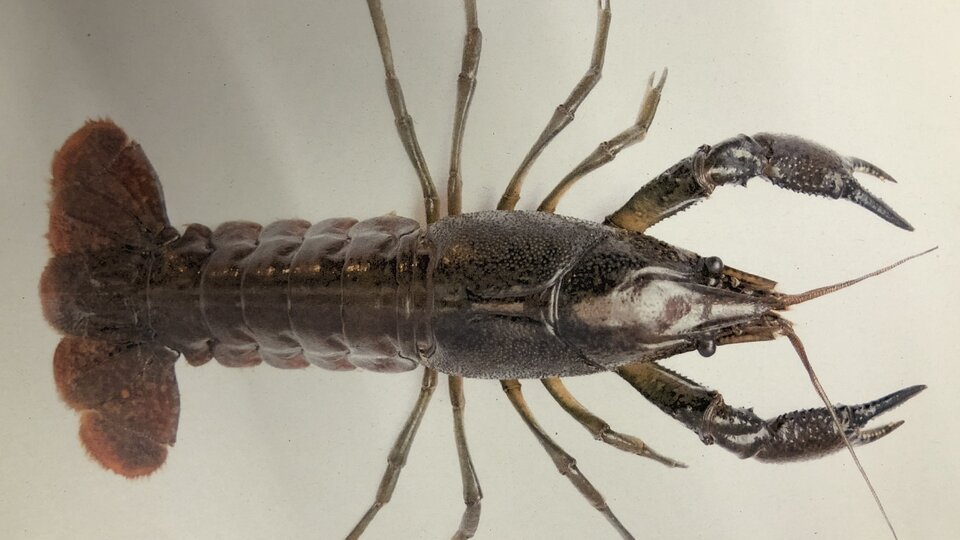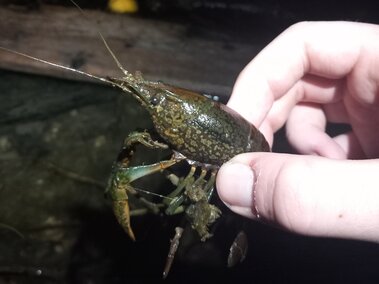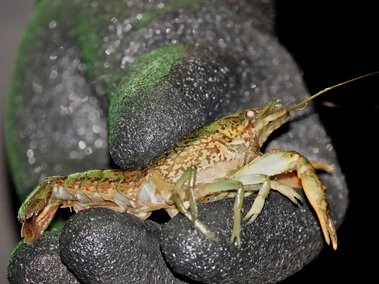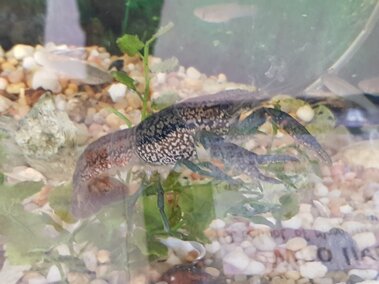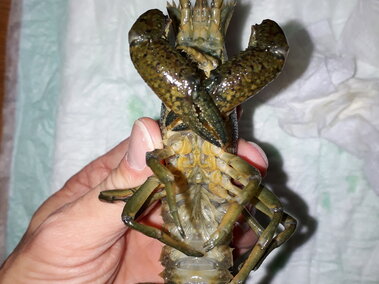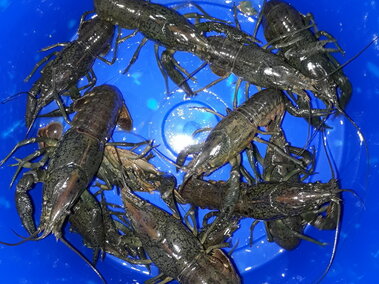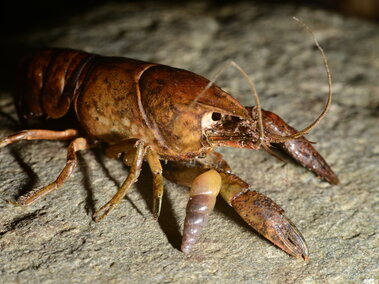General Information
Species Name: Procambarus virginalis
Also Known As: marmorkrebs
Family: Cambaridae (Crayfish)
Life Span: 2-3 years
Life Cycle: Sexual maturation occurs within the first 6 months of life when they reach about 4 cm (1.5 in), allowing marbled crayfish to reproduce multiple times throughout their lives. They reproduce through a cloning process known as apomictic parthenogenesis, meaning their eggs do not need to be fertilized by a male for them to develop and hatch. Photoperiod (day length) is the primary driver of reproduction in mature marbled crayfish.
The number of eggs that an individual female can produce per clutch has varied, but it is estimated to be between 200 and 700 eggs depending on body size.
Developing eggs are carried under the female’s abdomen and take 2-3 weeks to hatch (depending on temperature). Eggs remain attached to the female for approximately 26 days of life (post-hatch), where they grow and subsequently moult. Their second moult signals the end of juvenile development, at which point offspring leave the safety of their genetically identical mother’s abdomen and become independent. They stay close to their mother for several weeks before going off to explore on their own.
Origin: Europe
Injurious: No
Category 1: Potential Aquatic Invasive Species
Why Are They Invasive?
Marbled crayfish are thought to outcompete native crayfish species for resources like food and space, with their faster growing rates, very large clutches, and aggressive behaviour. Outcompeting native species can alter food webs and reduce biodiversity. They also have the potential to introduce disease such as crayfish plague to native species, which can eliminate entire populations.
People in Madagascar have reported negative impacts on the fishing industry, suggested to be a result of marbled crayfish predating on young, small fish. If introduced to the United States, it is possible that marbled crayfish will cause similar economic hardships in the freshwater fishing industry. This species also has the potential to affect agricultural practices, as it has been reported to reduce rice yields by damaging plants in Madagascar.
What Do They Look Like?
Marbled crayfish are medium sized crayfish reaching anywhere from about 7.5-13 cm (3-5 in) in length, which is about the same size as the diameter of a standard baseball. Their elongated chelae (claws) are small and are usually about half the length of their carapace (back).
Marbled crayfish get their name from their appearance. They all have a marbled pattern that covers their back and claws (but their legs are one uniform color). Even though they are genetically identical, they can differ in other traits such as color. They vary in color depending on their habitat, reflecting differences in diet.
Most individuals eating algae, plants, snails, and amphibians appear olive to brown in color when found in the wild. It’s usually easier to see more color variation in captive marbled crayfish, which can turn blue, red, and even green when given a special diet.
Regardless of overall color, every marbled crayfish has a darker horizontal stripe on each side of their carapace and pleon (abdomen) that runs through lighter colored areas.
Photos
Where Do They Live?
In places like Madagascar where there are now wild populations, marbled crayfish have been found living in a variety of freshwater habitats. They prefer lentic (slow-moving) waters, such as wetlands, lakes, swamps, ditches, and ponds, but have also been found in lotic (fast-moving) waters, such as rivers and streams.
Many marbled crayfish have also been found in rice paddies in the wild. They prefer habitats with water temperatures that range between 18ºC and 25ºC (64.4°F and 77°F). They can survive in much colder and warmer conditions, but the likelihood of mortality increases with each passing week.
In times of reduced water availability (e.g., drought), marbled crayfish create underground burrows in the soil or mud to find moisture.
How Do They Spread?
Marbled crayfish originated in 1995 at an aquarium in Germany. It is likely that mutations in a closely related species (the slough crayfish) led to the emergence of marbled crayfish as an entirely new species.
Marbled crayfish have been dispersed primarily through the pet trade, which has given them the opportunity to establish wild populations in several European countries, as well as Madagascar and Japan.
Trading of marbled crayfish has become very popular, but they can quickly outgrow home aquariums through rapid reproduction. When this happens, marbled crayfish are usually sold or released into bigger pools of water in the wild (such as garden ponds). From there they can spread out and colonize a diverse range of freshwater aquatic habitats.
The first reported sighting of marbled crayfish in North America was in 2004. Their potential to be released from household aquariums into the wild is high given their ability to rapidly produce hundreds of clones within a few months.
How Do I Control Them?
Contact the Nebraska Game and Parks Commission to determine appropriate control methods. To prevent their spread and introduction into your waterbodies:
CLEAN your watercraft, trailer, angling gear and other equipment. Remove all aquatic vegetation and animal species from your equipment.
DRAIN your watercraft at the ramp by removing the boat plug and draining all live wells and ballast tanks.
DRY your watercraft, trailer and other equipment for at least 7 days before visiting another waterbody.
DON'T DUMP BAIT. Dispose of bait by emptying bait buckets on dry land, away from waterbodies or in a trash receptacle. Moving a live organism from one waterbody to another is illegal, even if you are planning to use the organism as bait.
DON'T LET IT LOOSE. Do not release or transport exotic or non-native fish species to new ecosystems. It is unlawful to release any aquatic species into a waterbody other than the one from which it was harvested. Doing so can promote the spread of AIS.
What Should I Do If I See Them in Nebraska?
If you see marbled crayfish in Nebraska, you should report them to the Nebraska Game and Parks Commission's Aquatic Invasive Species (AIS) Program using their AIS Report Form. For guidance on what information to include in your report, check out our reporting tips.
